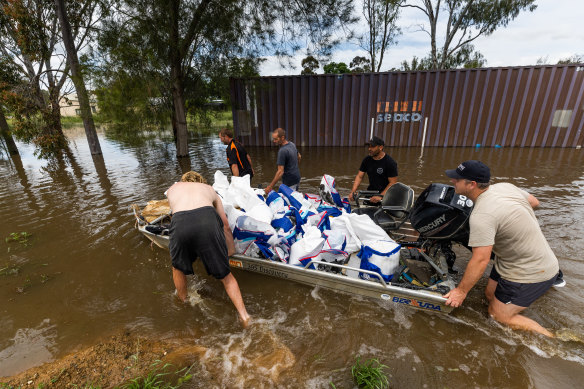
“However, decisions were taken today, in line with a stepped business continuity plan for the relocation, to postpone to move to allow our paramedics and medical teams to focus on the current flood emergency.”
It comes as floodwaters engulf large tracts of the state. Central Moree was flooded as the Mehi River neared a 10.7-metre peak late on Sunday, and evacuations were under way in Dubbo as water entered basements in the central business district.
The Dubbo Library and the Western Plains Tourist Park were also evacuated as the Macquarie River reached 7.57 metres, with more rises possible.
Residents of North Lismore were also warned to prepare for evacuation, with areas north of the Wilsons River and Leycester Creek expected to be heavily affected.
Residents of South Lismore, in streets located south of Leycester Creek and north of Hollingsworth Street, were also told to prepare to evacuate.
Floodwaters were expected to rise on Monday morning and peak on Monday night, possibly at a level of 9.7 metres.

Residents ship sandbags in Echuca, on the Victorian side of the border with NSW.Credit:Jason South
The State Emergency Service had 135 warnings in place on Sunday night, with Moama on the NSW-Victorian border, Lismore, Dubbo, Gunnedah and Moree among the worst affected.
NSW Emergency Services Minister Steph Cooke said there were “more flood threats in more communities and locations than at any other time this year”.
The Bureau of Meteorology’s Jane Golding has warned of “widespread inundation of rural and urban areas”.
“The Northern Rivers on the coast is the key area to be watching closely today and tonight and then as the system moves further southwards, the Mid North Coast and possibly the Hunter might come into play,” Golding said.
Prime Minister Anthony Albanese said flood warnings at present “stretch continuously right down the east coast” and residents in Queensland, NSW, Victoria and Tasmania should remain vigilant.
“We need to recognise that climate change is having an impact,” Albanese said.
He said 100 Defence Force personnel were assisting with flood preparation, community engagement and sandbagging in NSW and a further 50 ADF members were on standby.
The Bureau of Meteorology said extreme weather including thunderstorms, heavy rain and possibly hail were expected to persist until the middle of the week.
A severe weather warning was issued on Sunday afternoon for heavy rainfall in north-eastern NSW and south-east Queensland, and flood watches were in place for parts of the Greater Sydney, Northern Rivers, Hunter and Mid North Coast catchments.
“There is a risk of dangerous and potentially life-threatening flash flooding for these areas as well as major riverine flooding,” the bureau said in a statement.
The Herald understands that a planned move by the rescue helicopter from the Ballina base back to Lismore was thwarted by the current floods, leaving the air crews operating with less than the normal levels of equipment on hand for medical emergencies.
Other emergency services such as the Rural Fire Service operate aircraft in northern NSW, but the NSW Ambulance helicopter is the only emergency-equipped medical evacuation helicopter in the region.
Staff said they were ready to respond to emergencies but did not have the usual levels of equipment they would have if they were operating out of their former base.
The Lismore base was devastated by floods earlier this year. Staff returned to the site to find buildings wrecked, flight gear and medical equipment destroyed.
The Morning Edition newsletter is our guide to the day’s most important and interesting stories, analysis and insights. Sign up here.









 Add Category
Add Category